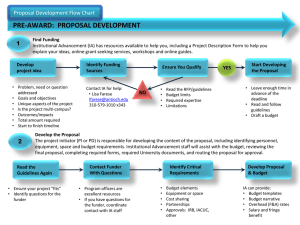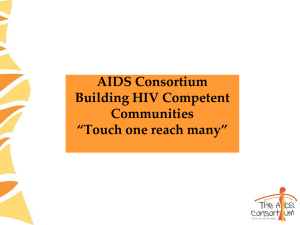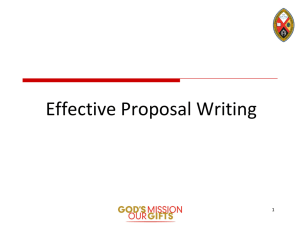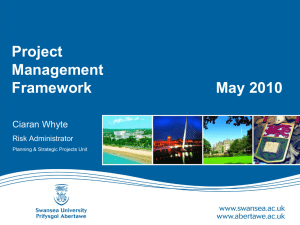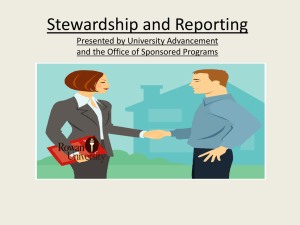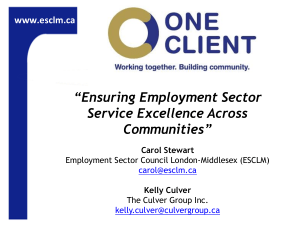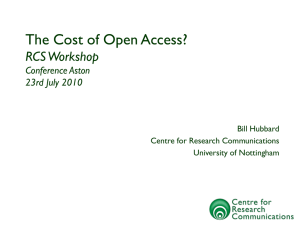Fundamentals of Grant Writing
advertisement
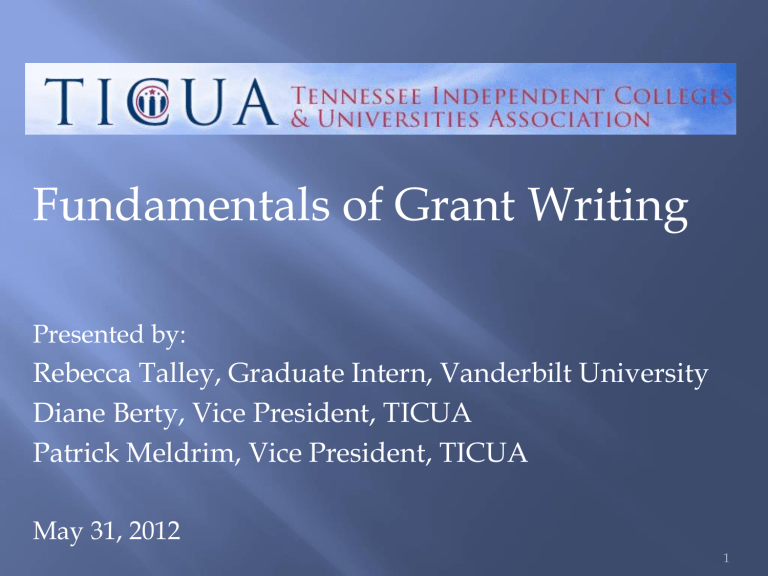
Fundamentals of Grant Writing Presented by: Rebecca Talley, Graduate Intern, Vanderbilt University Diane Berty, Vice President, TICUA Patrick Meldrim, Vice President, TICUA May 31, 2012 1 Overview • Giving Trends • Success and the Changing Environment • Grant Writing Basics • Checklist • Finding a Grant Maker 2 Overall grant-making declined 14.2 percent in 2009 Number of grants decreased 6.6 percent Education and health benefited from the largest shares of grant dollars Source: Foundation Giving Trends, 2011 3 Source: Foundation Giving Trends, 2011 4 Source: Foundation Giving Trends, 2011 5 2011-2013 Diversity in Teaching Grant: $100,000 of an available $375,784 2012 Improving Teacher Quality Grant: $73,291 of an available $716,115 2012 STEM Professional Development Grant: $428,416 of an available $4,604,607 Total amount awarded to TICUA member institutions in last THEC grant cycle: $601,707 Total amount available: $5,696,506 6 Additional Math Credit (total of 4) Algebra I, II, Geometry, and a fourth higher level math course Additional .5 credit in Physical Education and Wellness (total of 1.5) Total number of Science remains constant, but altered (total of 3) Total number of Elective Credits remains constant, but more specific (total of 6) Biology, Chemistry or Physics, and a third lab course Electives--Personal Finance: .5 Credits, Foreign Language: 2 Credits, Fine Arts: 1 Credit, Elective Focus: 3 Credits Capstone Experience Source: TN Diploma Project 7 The Common Core State Standards provide a consistent, clear understanding of what students are expected to learn, so teachers and parents know what they need to do to help them. The standards are designed to be robust and relevant to the real world, reflecting the knowledge and skills that our young people need for success in college and careers. The standards are available at http://tn.gov/education/curriculum.shtml Source: http://www.tncore.org/ 8 The reader is stupid Speak the funder’s language Follow directions Have a good elevator speech Follow your logic model Work ahead/ Don’t wait for the RFP to be issued Have measureable outcomes Establish alignment between the funder’s goals and your program’s goals Create continuity throughout each section of the grant/ the No Section Left Behind Act 9 Cover Page, Title Page and/or Abstract Section I: The Needs Statement Section II: Project Description Section III: Budget Request Letters of Support and Agreement/Commitment Appendix Materials 10 Purpose statement Goals and objectives which align with the funder’s mission Salient points of Needs Statement Activities as correlated to expected outcomes Statement of how to evaluate Usually only 2 paragraphs or word count provided by funder 11 One succinct sentence that articulates the NEED for your grant project An excellent tool for focusing your thinking because it states clearly what your project is all about Do not include the intervention You want the potential funder to become aware of the urgent need and ask, “What can we do?” 12 Create an Elevator Speech with your group 13 Gives the WHO and WHY WHO is being served and WHY do they need help? Makes a convincing case regarding the extent & magnitude of the needs Explains the effects of continued non-intervention Comprehensive but not BORING 14 Use supportive evidence State the contributing factors Identify gaps Discuss “promising” programs or “best practices” Put a face to the problems or needs by using quotes and anecdotes 15 Show a thorough understanding Show a knowledge of other interventions Show an awareness of barriers Show an alignment of missions and goals Set the stage 16 Relevance Currency Data and Statistics Authority 17 Section 1: The Nature and Extent of the Needs Section 2: Factors Contributing to the Problem Section 3: Impact of the Needs Section 4: Promising Approaches 18 Do not overdramatize the problem Avoid circular logic A “lack” does not imply a “need” Avoid jargon or undefined acronyms Refrain from mentioning your particular intervention Trying to fit an existing program to a grant that doesn’t match 19 Create a Needs Statement with your group 20 Provides the solution to the needs you have established Identifies the project’s goals and objectives. i.e. implementation plan, timeline Generates excitement Justifies your approach 21 1. Objectives (Intended Outcomes) 2. Program Activities 3. Staffing and Administration 4. Evaluation 5. Sustainability 22 Program Goals = Ultimate Mission of Your Project Program Objectives = Measureable Outcomes Outline the operating plan Demonstrate a match with funder Illustrate how you will measure the program’s success SMART 23 Goals are broad; objectives are narrow Goals are general intentions; objectives are precise Goals are intangible; objectives are tangible Goals are abstract; objectives are concrete Goals can't be validated as is; objectives can be validated Source: URL: http://edweb.sdsu.edu/courses/edtec540/objectives/Difference.html 24 Process Objectives: focus on the activities to be completed in a specific time period; enable accountability by setting specific activities to be completed by specific dates; explain what you are doing and when you will do it Outcome Objectives: express the intended results or accomplishments of program or intervention activities 25 Outputs: the direct products of the program activities Weekly workshops to model instrumentation implementation software and content resources. Outcomes: are the specific changes in program participants’ behavior, knowledge, skills, status, and level or functioning Increase the knowledge of 50% of middle schools teachers’ use of electronic education aids by 35% by June 30, 2012. 26 Time frame Target group Number of program participants Expected measureable results or benefits Geographic location Action verbs 27 Poor: One thousand youth between the ages of 12 and 16 will have participated in a 6-week education program on violence prevention. This is actually an output Revised: One thousand youth between the ages of 12 and 16 will increase their knowledge by 40% in conflict resolution and anger management by June 30, 2012. 28 Create Measureable Objectives with your group 29 Implementation Plan Project narrative Preparatory tasks Specific program-related activities Gantt Chart List the major activities Estimate amount of time of each activity will take Determine how this activity is spread across a time period Timeline 30 Source: W.K. Kellogg Foundation Logic Model Development Guide 31 Source: www.ProjectPlan.com 32 Staff Administration Collaboration 33 “Program Evaluation is the systematic assessment of program results and, to the extent feasible, systematic assessment of the extent to which the program caused those results.” Source: Handbook of Practical Program Evaluation (1994) 34 Formative Evaluation: is a method of judging the worth of a program while the program activities are forming or happening. The focus is on the process. Summative Evaluation: is a method of judging the worth of a program at the end of the program activities. The focus is on the outcome. Source: Bhola, H. S. 1990.Evaluating "Literacy for development" projects, programs and campaigns: Evaluation planning, design and implementation, and utilization of evaluation results. 35 Indicates the plan to continue the project beyond the requested funding period Finite, or Builds capacity, and/or Attractive to future funders 36 Create Evaluation and Sustainability Plan with your group 37 Action-oriented tool for program planning, implementation, and evaluation Systematic and visual way to present the relationships among resources, planned activities, and desired changes Used throughout the life of the program 38 Resources /Inputs Activities Outputs Outcomes Impact 1 2 3 4 5 Your Planned Work Your Intended Results Source: W.K. Kellogg Foundation Logic Model Development Guide 39 Resources /Inputs •Holiday flight schedules •Family schedules ` •Frequent flyer holiday options Activities Outputs Outcomes •Create family schedule •Tickets for all family members •Family members enjoy vacation •Get holiday flight info •Get tickets Impact •Continued good family relations •Frequent flyer miles used •Money saved •Arrange ground transportation •Holiday weather 1 2 Your Planned Work 3 4 5 Your Intended Results Source: W.K. Kellogg Foundation Logic Model Development Guide 40 Itemizes expenditures Includes rationale Typically a line-item budget Divided into three categories 1. Personnel costs 2. Operating expenses 3. Support and Revenue 41 Derived from Staffing & Administration section Determine salaries Determine time required Determine benefits 42 Source: US Dept. of Labor Bureau of Labor Statistics, 2011 43 Often measured in Full Time Equivalents (FTE) Expressed as a decimal 1.00 FTE = total $ paid to a person working full-time for 12 months If part-time: # hrs worked/week 40 Example: 10 hrs/week 40 X FTE .25 FTE 44 # hrs worked/week 40 median annual income 10 hrs/week 40 $58,210 .25 $58,210 $14,552.50 45 29.5 is the magic number Non-benefited employees: 7.65% Benefited employees: 28%-40% Calculated as percentage of total salary Example: (13% + 15%) 28% $14,552.50 $14,552.50 $4, 074.70 46 Derived from the Project Description Source: http://www.loopnet.com/Nashville_Tennessee_Market-Trends 47 Source: US General Services Administration, 2012 Source: IRS Standard Mileage Rates, 2012 48 Matching funds In-kind donations Participation fees charged 49 Indirect Costs cover additional operating expenses 10-15% of total budget Budget Justification or Narrative is a detailed description of each line of the budget 50 Availability Accessibility Acceptability Appropriateness Adequacy 51 Letters of Support reflect support for the proposed project from program recipients, community leaders, schools/universities, religious organizations, etc. Letters of Agreement are similar, but reflect a higher degree of commitment, acting as a pseudo-contract 52 When speaking with those that you would like to write either Letters of Support or Agreement provide each with: brief synopsis of proposed program funding source specific instructions, i.e. letter addressee, mailing address , deadline Letters of Support and Agreement should NOT be written from a “template or boiler plate” –letters should reflect the agencies’ and partners' own perspectives 53 Audited financial statement Insurance documentation Organizational charts I-990 Other information required by the funder 54 Cover Page, Title Page and/or Abstract The Needs Statement Project Description Objectives Program Activities Staffing and Administration Evaluation Sustainability Budget Request Letters of Support and Agreement/Commitment Appendix Materials 55 Cover Page Program Objectives Needs Statement Project Description—Objectives, Project Narrative Quality of Partnership Project Description—Evaluation Budget Effectiveness Project Description—Staffing and Administration, Program Activities, Sustainability Evaluation Plan Project Description—Collaboration Program Plan Cover Page, Title Page and/or Abstract Budget Letters of Commitment Letters of Support and Agreement/Commitment 56 Did we assume that the reader is stupid? Did we speak the funder’s language? Did we follow directions? Do we have a good elevator speech? Did we create and follow our logic model? Did we work ahead/Do we have a previous RFP? Do we have measureable outcomes? Did we establish alignment between the funder’s goals and our program’s goals? Did we create continuity throughout each section of the grant? 57 Create an accurate and allowable budget Express continuity Be explicit Know your target population Be SMART Consider barriers Review credentials Proof read 58 Waiting until RFP is issued: some grants issued annually or bi-annually Missing material and technical issues Lack of alignment or beyond the scope Bad data Not adhering to page limits 59 For a list of references, please see the Resource Guide PowerPoint presentations, Resource Guide, and Primer can be found online at www.ticua.org/meetings_resources/grants Contact us: Diane Berty berty@ticua.org Patrick Meldrim meldrim@ticua.org Rebecca Talley talley@ticua.org 60
